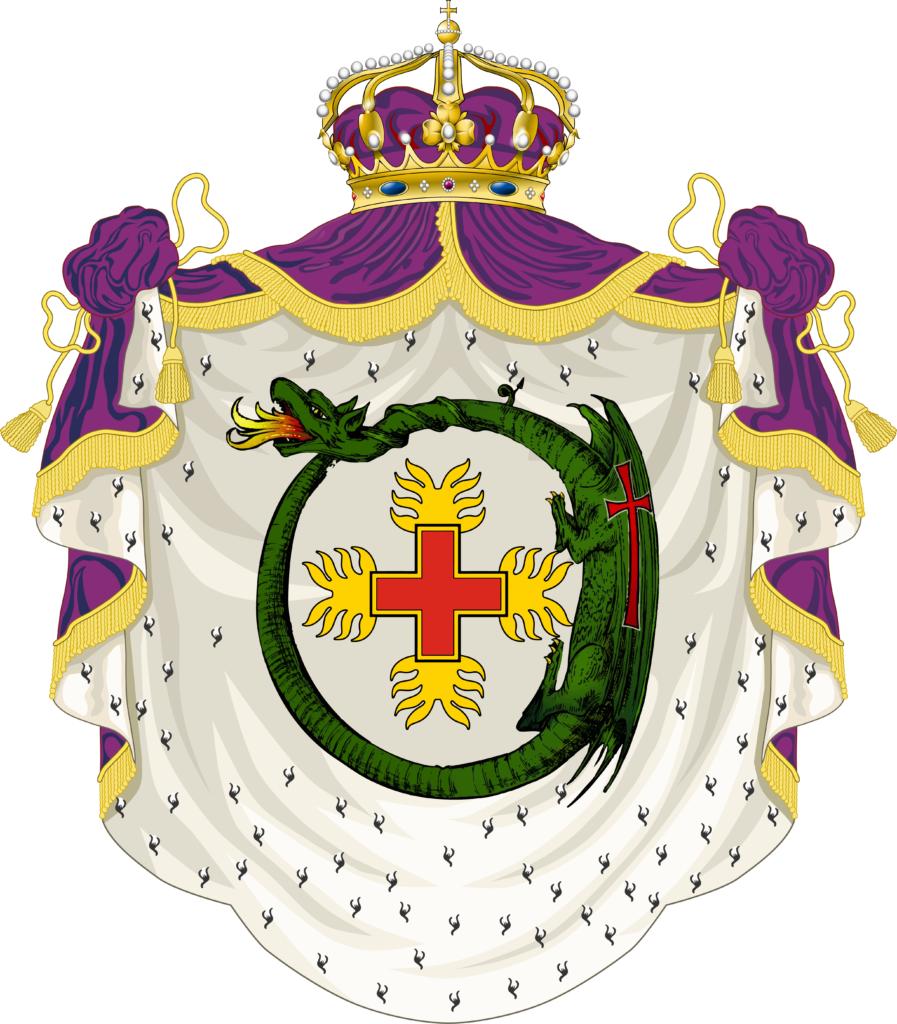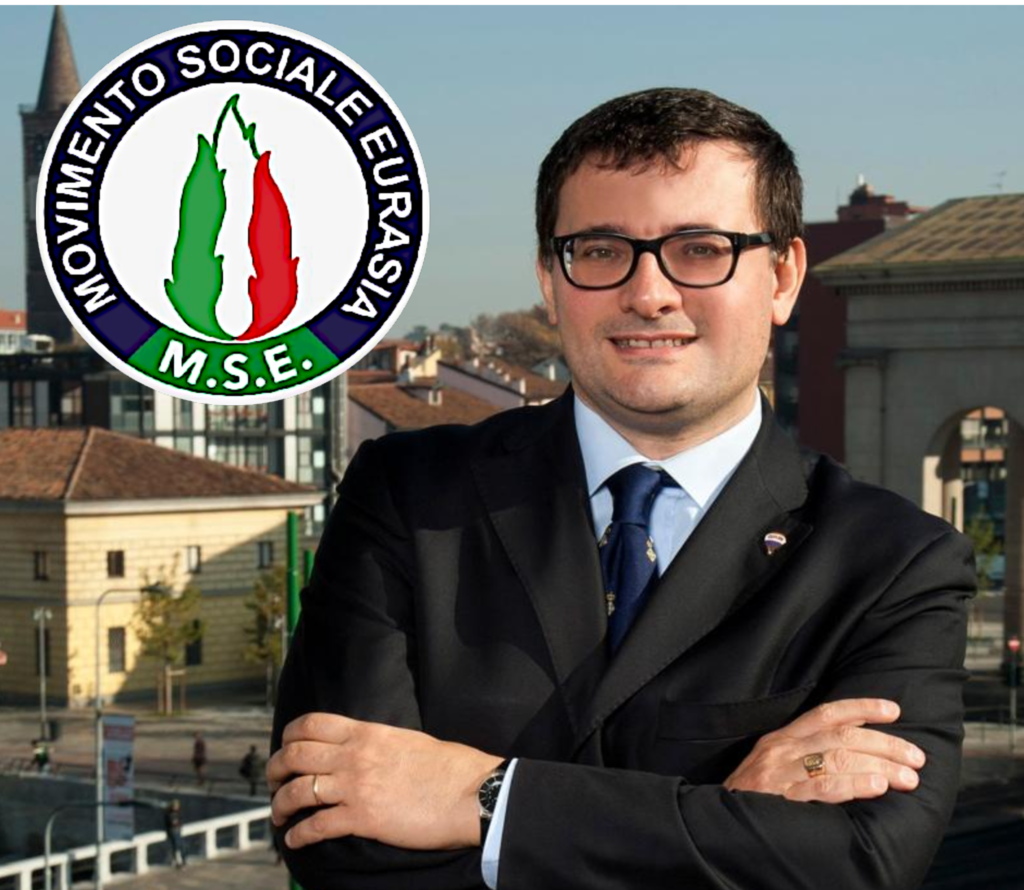Emperor Vlad Tepes III “Dracul” was a merovingian
To many Romanians, till nowadays the legendary Emperor of Vallachia and Transylvania is still a hero. According to romanian tradition, Count “Dracul” Vlad Tepes III, was the legitimate protector of Christianity and a fierce warlord just to protect his own people. He was known to had himself pierced his opponent’s guts with sharp poles, thus suffocating them in their own blood.
“Dracul” means Devil in the Romanian language, and the Dragon in the Middle Ages was the mythological monster that represented him; in fact, the symbol of the Order of the Dragon, to which Vlad Tepes III belonged, was precisely a prostrate Dragon, on whose back a cross was placed, thus representing the Devil in the service of God’s will.

One day, the Emperor insisted that everybody, from the nobles to the peasants, submit to his rules or “face consequences of their disobedience”. History witnessed the Emperor wasn’t bluffing, when he invited at court for a big feast the landlords that were considered a burden to the country with their unloyalty, stealing by not paying tributes or obstacoling economic growth or the political stability of the country. During the sumptuous feast, Emperor Vlad Tepes III proclaimed that no one should fell hungry, poor or disappointed in his land. The guests ate and drank till late night, when the Emperor appeared and asked the assembled crowd, “Do you all want to live without any preoccupation, lacking nothing in our country?” When the answer was affirmative, Vlad Tepes III gave a sign to his guards to kill by sword all the present. Vlad explained his action by saying, “No one will feel disappointed of the reign in my realm.”
“Dracula” was the honorific name given to Vlad Tepes because, like his father before him, he belonged to the Holy Order of the Dragon, a knightly Order dedicated to fighting Turks and heretics.
The lineage arrived uninterrupted till nowadays
John Lackland “John of England”, ancestor of the actual Stuarts, was merovingian as well, according to the genealogic records, as his ancestors were the Merovingian Kings, which semantic roots means “Mer” that stays for “coming from the sea” and “Vingios” that stays for “Serpent”, that combined together means “Serpent coming from the sea”. As a consequence of this traditional root, comes the origin of the name “Order of the Dragon”, celebrating the Serpent came from the sea.
That explains why, browsing the genealogy of kings and nobles, we find such a recurring symbology including snakes or dragons.

ORDO DRACONIS (ORDER OF THE DRAGON) TODAY
The Imperial Order of the DRAGON is an ancient Christian knightly order, founded in 1408 by the Emperor Sigismund, then of legitimate private collation of the Imperial House of Cantacuzene of Byzantium (Voivodes, Sovereign Princes of Wallachia, Moldavia and Transylvania) Its Knights are also called Imperial Dragons or Flaming Knights and the Order is officially recognized by the Holy Orthodox Church , inside the Ecumenical Patriarchate of Constantinople.
The Imperial Order of the Dragon was known as Ordo Draconis and became known to public having between its members Prince Vlad Tepes III of Wallachia, the fictionalized Count Dracula, actually a Romania’s national hero and a revered Christian Knight in the fight against the Turkish-Islamic Ottoman invasion of the Carpathians, therefore of Europe.
The novels and myths about Count Dracula, a vampire from Transylvania, are symbolic and esoteric legends that inspired novels till nowadays as cinema and various kind of literature.
WHAT INSPIRED THE MYTH
The fictional myth about Vld Tepes III Count of Valacchia, is based, upon certain aspects, on a true story, namely that of Voivode Vlad III Basarab Draculesti (1431-1477), Sovereign Prince of Wallachia, Knight of the Imperial Dragon Order, he was a ruthless leader against the Ottoman Turkish advance in the Carpathians, his determination, ruthlessness and ferocity, were decisive to protect the country from the ottoman invader.
The conflict reached extremes never seen before in Romania and unmerciful measures were taken even against traitors, who wanted to gain advantages from the fortunes of the enemy.
It’s still known to chronicles, when Count Vlad – as aforementioned in the present biography – identified the most dangerous traitors, invited them to a feast, where they were slaughtered and impaled outside the castle walls.
It was after that episode, the Count was nicknamed Vlad “The Impaler”.
Though its ruthlessness, Count Vlad Tepes III was always known and remembered as a national hero and a powerful defender of Christianity by the romanian people and the Orthodox Church itself, having, with faith and sword, eradicated the muslim invasion of Romania and therefore of Europe. The Romanian and Hungarian nobles engaged in this defense were all “Imperial Dragons”, or knights of the Ordo Draconis, founded by the Emperor Sigismund in 1408 and recognized by Pope Eugene IV in 1433. This ennobling Christian order, purely military, had and has as insignia a tame dragon eating its own tail, with a flaming cross in the center, Christianized pagan esoteric symbols, with a powerful evocative meaning that inspired respect in the soldiers and the people, and the right and desired fear in the Islamic invaders. In this regard, we recall, in addition to Saints George Megalomartyr and Michael the Archangel, the figure of Saint Margaret of Antioch who, with the power of a cross of fire, guts the dragon that devoured her and tames it, transforming the demonic beast into a docile guard animal.

The Order of the Dragon still exists, in its legitimate legacy as a legitimate family collation of the historic Romanian Byzantine Imperial House of Cantacuzinos (Despots of Morea, Gospodari of Wallachia, Voivodes of Moldavia and Pazniki of Transylvania), represented by H.I.H the Prince Grand Master Pieter, member of the Union of Byzantine Nobility, under the protection of the Ecumenical Patriarchate of Constantinople. The Order is of Orthodox Byzantine Christian tradition but ecumenically open to all good Christians, aristocratically selected from among the best patriots, willing to concretely defend Christianity, which today means European Christian civilization and identity affected by cultural and moral decadence. The Imperial Order of the Dragon is also protector of the Eastern Christian brothers persecuted, especially in Islamic countries. The Order has a unique class and merit, fraternal and ennobling (personal nobility not hereditary), of Knight Dragon, and only a hierarchy of organizational, territorial and seniority roles, similar to the military one. Since the 1950s, the Order has also been open to women, Dame Dragonesse, who, however, cannot assume hierarchical positions.
THE ACTUAL HEREDITARY REGENT, H.I.H. Prince Pieter Cantacuzini
The Ordo Draconis foundation is dated back to 1837 and is still perpetuated by legitimate transmission line, characterized by an ecumenical Christianity of historical collation of the Cantacuzino Imperial House (Despots of Morea, Princes of Byzantium, Gospodari of Wallachia, Voivodes of Moldavia, Pazniki of Transylvania), under the spiritual protection of Saint Margaret of Antioch of the Holy Orthodox Church.
The Ordo Draconis is headed by its actual Sovereign Regent, H.I.H. Prince Pieter Cantacuzini.

The Order of the Dragon (Ordo Draconis) was established in 1387 by Sigismund of Luxembourg, King of Hungary and Emperor of the Holy Roman Empire, with the subsequent apostolic blessing of 1433 by the Roman Pontiff Pope Eugene IV, as a new military political tool for fight the Ottoman advance in the Carpathians and the Balkans.
It was a real call to arms, addressed to the aristocracy, to a new defensive crusade in southeastern Europe. And in fact the operation was successful because the various Christian princes, sovereigns and feudal lords of those lands, often rival and quarrelsome, united in the Order of the Dragon, managed to stop the Turkish military invasion and the Islamization of Europe.
With the main branch of the rulers of Wallachia extinct, in 1660, the protection of the Order passed as an inheritance to Prince Constantine Cantacuzino (1650-1716), son of Princess Elina Bassarab Draculesti, and to her successors. Prince Constantine, a Romanian Wallachian philosopher and scholar, studied in Constantinople, then in Padua and Venice, spoke Greek, Latin and Italian perfectly, and, deeply Orthodox religious, obtained the blessing of the Ecumenical Patriarch Methodius III who placed the Order of the Dragon under the Spiritual Protection of Saint Margaret of Antioch, the very young Christian martyr who, according to the legend, with the strength of the Faith, tamed an evil dragon, making it a docile instrument of good.

The Cantacuzini are an ancient Romanian princely family of Byzantine Phanariot origin, descendants of the Despots of Morea and the Emperor (and Orthodox monk) Giovanni VI Cantacuzeno, related to the imperial dynasties of the Angelo and the Palaiologos, with the Ases kings of Bulgaria and with the Orsini Princes of Epirus. After the fall of Constantinople they moved to the Carpathian region where over the centuries they directly ruled Wallachia (1678-1715) and, indirectly, by marriage and dynastic alliances, also Moldavia (ownership inherited from the Musatini Princes) and Transylvania (more as a Romanian Orthodox claim in contrast to the Austro-Hungarian Catholic Empire), so much so that it is considered as the first true sovereign dynasty of Romania.
The Order of the Dragon of the Cantacuzene Imperial House followed all the historical events of the dynasty and the region, even the tragic Communist interlude, up to the present day, with a documented and uninterrupted organization, with ups and downs.
INTERNATIONAL NOTABLE MEMBERS OF THE IMPERIAL ORDER OF THE DRAGON
H.E. Most Reverend Father Claudiu Ioan Cocan, Plenipotentiary Imperial Ambassador, with the historic Byzantine honorific title of sebastocrator, Prior of the Imperial Order of the Dragon, and Priest of the Romanian Orthodox Church
Baron Roberto Jonghi Lavarini one of the greatest Italian experts in the traditions and customs of chivalry and nobility of the Eastern Byzantine and Orthodox world. Baron Roberto Jonghi Lavarini, is even a very popular intellectual, also actively engaged in politic, as actually Spokeperson of the M.S.E Movimento Sociale Eurasia, which is a refoundation of the historical italian right wing Party Movimento Sociale Italiano, dissolved in 1995.

H.R.I. the Prince, Prof. Don Roberto Spreti Griffo Focas Flavio Angelo Ducas Comneno of Cefalonia (Presidente of the Byzantine Nobility Union)
H.I.H. Prince Ezra Annibale Theo Paterniano Foscari Widmann Rezzonico Tomassini Paternò Leopardi
Reverend Hyerodeacon Father Ambrogio (Michele Maria Pirotta) – Sacred Orthodox Archdiocese of Italy – Pavia (Ecumenical Patriarchate of Constantinople)
Noble Doct. Iacopo Bajon Severi Salazar
Atty. Gianfranco Bartolelli
Baroness Lucia Chelcea di Baile Herculane
Professor Angela Campanella
Countess Mandilosani Lali Panchulidze

Mr. Paolino Campinoti
Countess Amalia Ioana Cocan
Reverend Doct. Padre Laurian Cozmin Rus
Mr. Mirko Cuneo
Atty. Julia Cupsa Kiseleff
Doct. Giovanni Flamma (president of Dante Alighieri cultural cercle)
Atty. Max Francioli
Mr. Alessandro Fratini
Mr. Giulio Fratini
H.E. Antonino Iuculano
Marquis Don Costantino Lebano di Lustra Cilentano
Mr. Raffaello Matraia
Noble Professor Marco Matucci Cerinic dei Signori di Brac, Vice-Deputy of the Imperial Order of the Dragon in Italy.
Noble Alessandro Giusti Menotti
H.E. Marco Rigamonti, Most Serene Grand Master of the Prieuré de Sion Ordre de la Rose-Croix Véritas O.D.L.R.C.V.

N.H. Conte Enzo Modulo Morosini di Risicalla e Sant’Anna Morosina
Atty. Vetullio Mussolini
Count Massimo Paltrinieri di Carpi
Mr. Fabio Petrarca
Count Alessandro Mathis Piumatti Sabotero di Caccioma e Carpenea
On. Eng. Romulus Popescu (President of the Romanians in Italy Association)
Marquis Giacomo Salviati di San Fiorenzo
Count David Simpson Cunningham of Kettilstone
Ms. Margherita Siracusa
Commander Paolo Omodei Zorini
Bibliography and Sources
- Radu Florescu-Raymond T. Mc Nally, Dracula, 1976, Cappelli Editions, Bologna.
- NPR News https://www.npr.org/sections/thetwo-way/2012/11/08/164681953/why-prince-charles-has-a-stake-in-transylvania?t=1643676695830
- Telegraph https://www.telegraph.co.uk/news/uknews/prince-charles/9656769/Prince-Charles-heir-to-Draculas-blood-line.html
- Transylvanian Review, vol. 5, Romanian Cultural Foundation, 1996
- https://www.notiziarioaraldico.info/2022051118321/lordine-del-drago-a-cuggiono/
- https://www.affaritaliani.it/milano/aristocrazia-nord/san-paisios-festa-ortodossa-romena-a-milano-foto-684240.html
- https://www.gazzettadellalombardia.it/ordine-del-drago/
- https://www.consulpress.eu/unione-della-nobilta-bizantina-e-ordini-nobiliari-della-corona-heracliana-e-di-santa-sophia/

